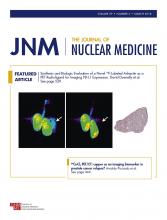TO THE EDITOR: Radiolabeled somatostatin agonists are valuable tools for imaging and treating neuroendocrine tumors. Although somatostatin receptors are also expressed in lymphomas, breast cancer, renal cell carcinoma, and small-cell lung cancer, imaging trials showed that somatostatin agonists are not accurate enough for either staging or effectively treating these tumors (1–4). On the other hand, antagonists, such as JR11, may display higher occupancy of somatostatin receptors and higher residence time in tumor tissue. Indeed, a small pilot study in patients with advanced neuroendocrine tumors found that 177Lu-DOTA-JR11 delivers tumor doses that are approximately 3.5 times higher than those obtained with 177Lu-DOTATATE (5).
The recent article by Reubi opens new exciting avenues (6). Using sst2 in vitro autoradiography on tissue sections, Reubi and colleagues found that 125I-JR11 was associated with a significantly higher labeling intensity (sometimes ×10) than the agonist 125I-Tyr3-octreotide, not only in classic endocrine tumors, but also in breast cancer, renal cell cancer, non-Hodgkin lymphoma, and small cell lung cancer (6).
Labeling intensity was, however, highly variable (e.g., from <1,000 to >10,000 dpm/mg in breast cancer). A high intensity (>4,000 dpm/mg) was found in about one third of samples of breast cancer (5/13), renal cell cancer (5/12), and non-Hodgkin lymphoma (5/15) (Tables 1–3 in Reubi et al. (6)). Therefore, selected patients may benefit from peptide receptor radionuclide therapy. A more accurate characterization of the individual tumor samples reported by Reubi and colleagues would have been useful for identifying these patients, notably, whether the sample was obtained at initial diagnosis or from a pretreated patient or from primary or metastatic tumor, and the tumor characteristic (e.g., estrogen receptor status of breast cancer cases, Fuhrman grade of renal cell cancer, subtypes of non-Hodgkin lymphoma cases).
Moreover, antagonists significantly bind to peritumoral vessels and this might allow for additional targeting during peptide receptor radionuclide therapy. Interestingly, even peritumoral vessels that were unlabeled by the agonist displayed strong labeling with the antagonists (Tables 1 and 2 in Reubi et al. (6)). Do the authors have an explanation for these findings? It would be interesting to know whether sst2a immunohistochemistry was performed on these tumors and how immunostaining correlated with autoradiography intensity.
In some tumors (e.g., colon cancer), antagonists did not bind to cancer cells but still bound to sst2 receptors in peritumoral vessels, lymphatic follicles, and mucosa (Supplemental Table 1 in Reubi et al. (6)). Comparing the uptake by healthy and inflammatory tissues with antagonists and agonists is then also important for understanding the relative merits of each class of compounds. This information should be accessible to the authors, who previously analyzed the uptake of agonists (7).
Reubi and colleagues pointed out that, in many cases, labeling of the tumoral sample was heterogeneous (6). Heterogeneity in tumor targeting may drive the choice of the radionuclide to be used and may also warrant dual targeting. For example, combining sst2 and CD20 targeting in non-Hodgkin lymphomas might further increase efficacy compared with CD20 targeting alone. Also, whereas small cell lung cancer displayed strong labeling with the somatostatin antagonist (6), the presence of other targets, such as CXCR4 (8), may allow for additional targeting. Finally, gastrin-releasing peptide receptor is highly expressed in estrogen receptor–positive breast cancer (9). Since Reubi and colleagues pleaded for multireceptor targeting in breast cancer (10), we would like to solicit their opinion on the complementary role between sst2 and gastrin-releasing peptide receptor targeting.
Footnotes
Published online Aug. 17, 2017.
- © 2018 by the Society of Nuclear Medicine and Molecular Imaging.







